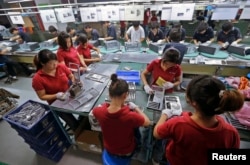Something strange is happening to the international labor market. Soaring costs and a changing labor environment in Asia have brought back American jobs that moved overseas in recent years. But experts warn that those returning jobs are small in number, and that American companies are still basing the bulk of their production abroad.
Several leading U.S. companies have announced plans to bring back highly skilled jobs from overseas, expand existing U.S. factories or build new ones. The reasons, they say, are increasing regulations, slower demand, a shortage of skilled labor and significant salary hikes throughout Asia.
Apple: Investing $100 million, bringing back 200 jobs
General Motors: Building a $258 data center in Colorado; plans to hire fewer than 10,000 workers
Oracle: Restoring 130 jobs from Mexico, retaining 300 in Oregon
Chrysler: Investing $374 million in transmission factories, bringing back 1,250 jobs to Indiana
General Electric: Relocating one of its facilities to Georgia, bringing back 400 jobs
Ford: Investing $200 million, adding 450 jobs in Ohio; moving production from a Mexico facility to Michigan, plans to add 12,000 U.S. jobs by 2016
In China, factory wages jumped 18.9 percent in 2011 and 20 percent last year, according to the National Bureau of Statistics of China. It projects an increase by more than 9 percent this year.
And China is not the only nation reporting such increases. India is expected to post wage increases of more than 10 percent this year, the Philippines 7.3 percent and Malaysia six percent, according to Aonl-Hewitt, a global consulting firm.
Typically, companies relocating jobs are multi-national firms that are moving “around the margin,” said Andy Tsay, chief of the Operations Management and Information Systems department at Santa Clara University in California.
These companies, he said, make their decisions based on a variety of factors, including the cost of labor, fuel, land and equipment, the proximity of customers and suppliers, the complexity of the product, and the scarcity of skilled labor.
“If you hold all of them equal and … lower the cost of labor in one place, then yeah, it wouldn’t be surprising to see more of the jobs go,” Tsay said.
But Alan Tonelson, a scholar with the Washington-based U.S. Business & Industry Council, said there is another important factor – the “very substantial payments and tax breaks from state and local governments.” This, he said, is enticing many companies to bring jobs back to the United States, set up new factories or expand old ones.
“That certainly sends signals to companies that it’s going to be a favorable climate for producing in the United States,” added Scott Paul, president of the Alliance for American Manufacturing.
Even so, the local and state tax breaks haven't resulted in an avalanche of jobs returning to the U.S.
One reason is that many modern products are made up of parts made in a variety of countries.
A case in point is U.S. High tech giant Apple, which plans to invest $100 million to manufacture one of its product lines, the iMac desktop computer, in the United States, thereby creating about 200 jobs. But the company’s basic components manufacturer, Foxconn, continues to operate in China with more than a million workers.
To make a tangible contribution, said Santa Clara University's Tsay, the entire overseas component ecosystem would have to move back to the U.S., along with dozens of companies and the educational system needed to provide them with the people with the right skills.
Short of that, the impact of the incoming jobs on employment or economic growth in the U.S. will be negligible, according to both Tsay and Paul.
U.S. manufacturers added 14,000 jobs in February, according to U.S. labor statistics. But experts such as Tonelson noted that the manufacturing sector is still about three percent smaller than it was at the end of 2007.
“It’s a little bit too early to say that we are seeing some major trends,” said Tsay.
Moving jobs from one continent to another is an expensive undertaking, Paul added, because it could require establishing factories and investing in equipment.
But he was optimistic that more jobs might come back five years from now due to lower U.S. energy costs, rising wages abroad, shifting currency exchange rates and intellectual property theft challenges in Asia.
“If you look at cost factors over the coming decade,” Paul said, “I think that you see the United States becoming even more cost-competitive.”
Several leading U.S. companies have announced plans to bring back highly skilled jobs from overseas, expand existing U.S. factories or build new ones. The reasons, they say, are increasing regulations, slower demand, a shortage of skilled labor and significant salary hikes throughout Asia.
Some of the firms bringing back jobs to the US
Some of the firms bringing back jobs to the US:Apple: Investing $100 million, bringing back 200 jobs
General Motors: Building a $258 data center in Colorado; plans to hire fewer than 10,000 workers
Oracle: Restoring 130 jobs from Mexico, retaining 300 in Oregon
Chrysler: Investing $374 million in transmission factories, bringing back 1,250 jobs to Indiana
General Electric: Relocating one of its facilities to Georgia, bringing back 400 jobs
Ford: Investing $200 million, adding 450 jobs in Ohio; moving production from a Mexico facility to Michigan, plans to add 12,000 U.S. jobs by 2016
And China is not the only nation reporting such increases. India is expected to post wage increases of more than 10 percent this year, the Philippines 7.3 percent and Malaysia six percent, according to Aonl-Hewitt, a global consulting firm.
Typically, companies relocating jobs are multi-national firms that are moving “around the margin,” said Andy Tsay, chief of the Operations Management and Information Systems department at Santa Clara University in California.
These companies, he said, make their decisions based on a variety of factors, including the cost of labor, fuel, land and equipment, the proximity of customers and suppliers, the complexity of the product, and the scarcity of skilled labor.
“If you hold all of them equal and … lower the cost of labor in one place, then yeah, it wouldn’t be surprising to see more of the jobs go,” Tsay said.
But Alan Tonelson, a scholar with the Washington-based U.S. Business & Industry Council, said there is another important factor – the “very substantial payments and tax breaks from state and local governments.” This, he said, is enticing many companies to bring jobs back to the United States, set up new factories or expand old ones.
“That certainly sends signals to companies that it’s going to be a favorable climate for producing in the United States,” added Scott Paul, president of the Alliance for American Manufacturing.
Even so, the local and state tax breaks haven't resulted in an avalanche of jobs returning to the U.S.
One reason is that many modern products are made up of parts made in a variety of countries.
A case in point is U.S. High tech giant Apple, which plans to invest $100 million to manufacture one of its product lines, the iMac desktop computer, in the United States, thereby creating about 200 jobs. But the company’s basic components manufacturer, Foxconn, continues to operate in China with more than a million workers.
To make a tangible contribution, said Santa Clara University's Tsay, the entire overseas component ecosystem would have to move back to the U.S., along with dozens of companies and the educational system needed to provide them with the people with the right skills.
Short of that, the impact of the incoming jobs on employment or economic growth in the U.S. will be negligible, according to both Tsay and Paul.
U.S. manufacturers added 14,000 jobs in February, according to U.S. labor statistics. But experts such as Tonelson noted that the manufacturing sector is still about three percent smaller than it was at the end of 2007.
“It’s a little bit too early to say that we are seeing some major trends,” said Tsay.
Moving jobs from one continent to another is an expensive undertaking, Paul added, because it could require establishing factories and investing in equipment.
But he was optimistic that more jobs might come back five years from now due to lower U.S. energy costs, rising wages abroad, shifting currency exchange rates and intellectual property theft challenges in Asia.
“If you look at cost factors over the coming decade,” Paul said, “I think that you see the United States becoming even more cost-competitive.”











